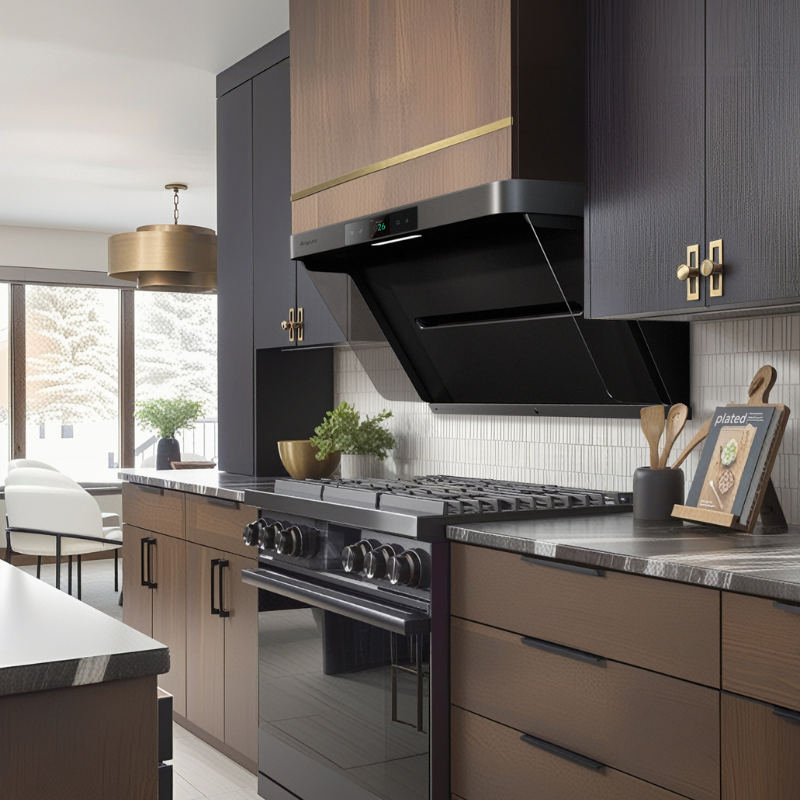The Ultimate Guide to Range Hood Technology and How It Works

The range hood is the kitchen's quiet hero. It operates over your stove. It keeps your house safe from grease, smoke, and food odors. But have you ever thought about how this valuable machine operates? Homeowners make their selection of a range hood based on how it looks. They don't get into the technology within. This guide will take you all the way into the guts of the range hood. It will tell you how it operates. It will tell you how important technical terms function too. This will make you a master buyer.
What Is a Range Hood?
A range hood is a kitchen appliance. It is fixed over a cooktop. It consists of a fan inside. This fan produces suction. It is designed to trap and take away the substances created during cooking. These substances are grease, smoke, steam, heat, and odors. All it doesn't do is purify the air. All it does is to exhaust the dirty air away from your cooking space. What the two primary types of range hoods do to move this air around distinguishes them.
Ducted vs. Ductless
This is the most important choice you will make. It determines how well your ventilation system will perform. It also determines how it will be installed.
The Power of a Ducted Range Hood: How It Works
So, what does a ducted range hood do? It operates in a simple and very nice manner. The fan collects the smells from cooking. After that, they go into a network of sealed pipelines. Ductwork is what these pipes are called. The ducting goes straight outside your house. A ducted range hood gets rid of all the unpleasant stuff in your kitchen. This comprises smoke, grease, heat, and water vapor.

This is therefore the best option for performance. This is fantastic for someone who cooks a lot of things that are really hot or very fatty. The only bad thing about it is that it has to be installed. It's harder and costs more. It has to have a way out.
The Flexibility of Ductless Systems: How It Works
A ductless range hood works in a completely different way. It pulls in the air. But it doesn't let air out. It cleans the air via filters. And sends the clean air back into the kitchen. First, the air flows through a metal filter to get rid of the oil. Then it goes through a filter made of charcoal. This filter is used to get rid of smoke and smells.
The best thing about a ductless hood is that it can go anywhere. There are no ducts needed. So it fits in every kitchen. Yes, even condos. But it doesn't work as well as it should. It doesn't get rid of water vapor and heat in the air. And you have to replace the charcoal filters often for them to work well.
CFM and Sones Explained
When you review range hoods, you will see two noteworthy ratings. They are Sones and CFM. Understanding them will make it possible to have a trade-off between strength and comfort.
CFM (Cubic Feet per Minute): More Than Just a Number
CFM refers to the amount of airflow that a range hood fan has the ability to move per minute. A higher CFM capability indicates that it has the ability to move increased airflow. However, bigger isn't always better. A very high-power hood may become noisy and inefficient in the consumption of power. What you seek to do with this is to scale the CFM to your cooktop appropriately. A good guideline on gas ranges is to have 100 CFM per 10,000 BTUs of power.
Sones: The Real Measure of Noise
Nobody desires a range hood that roars like a jet plane. That's how it's measured: in Sones. A person comfortable with numbers finds the Sone scale simple to comprehend. 2 Sones sound twice as loud as 1 Sone. A quiet refrigerator is in the 1-Sone bracket. A normal level of conversation registers around 4 Sones. In-store, you should seek out a low Sone level on the fan's lower, everyday-use settings.
How Range Hood Technology Has Evolved
For decades, range hoods were measured mainly by their airflow volume (CFM). But real performance involves more than just CFM; it’s about how effectively the airflow targets and traps cooking fumes at their source.
Modern range hoods have evolved from brute-force suction to intelligent, high-speed airflow systems. Advanced aerodynamic designs now direct smoke capture precisely where it forms, improving efficiency while reducing noise. For instance, Arspura’s IQV™ Technology uses an inclined quad-vortex structure to create an invisible air curtain that locks smoke within the cooking zone. It combines 13–15 m/s ultra-fast airflow with intelligent sensors to remove PM2.5 and odors in 0.03 seconds, setting a new benchmark for clean-air performance.

Range Hood Filters
Filters are the crucial components that get down and dirty. There are two fundamental types you should know.
Grease Filters (Baffle or Mesh)
They are your first line of protection. They come in both ducted and ductless hoods. Their only job is to intercept grease in the ventilation air. Baffle filters are generally superior and longer-lasting than simple mesh filters. They also clean up more easily.
Charcoal Filters
These are the cores of a ductless range hood. The charcoal is quite effective at trapping smoke and absorbing odors. But these filters become full in due course. So they have to be changed every 3 to 6 months to perform well.
Filterless Design
While traditional systems rely on physical filters that trap grease and require regular cleaning or replacement, modern innovations have changed the game. Arspura’s filterless design, for instance, eliminates the need for mesh or charcoal filters entirely. Instead, it uses high-speed airflow separation to spin grease particles out of the air before they can settle—keeping performance strong and maintenance minimal. No more greasy filters, no more frequent replacements. Just continuous, powerful ventilation.

The Future of the Kitchen: What is a Smart Range Hood?
Technology is now in the kitchen ventilation world. It has created a new kind of smart appliance. A smart range hood uses sensors and Wi-Fi to make your kitchen experience easier.
A smart range hood could potentially have such functionalities:
- Heat and Smoke Sensors: Your hood senses the heat and smoke of your cooktop. After that, it may adjust its fan speed automatically.
- Cooktop Synchronization: Some models also have a feature to connect to a cooktop. They come on automatically while you start to cook.
- App and Voice Control: It can also be controlled with your phone or voice.
- Alerts on Maintenance: Your system will notify you that you need to clean or change your filters.
Making the Final Call: How to Choose Your Perfect Range Hood
Now you understand the technology. So you can follow a simple, smart process to find the right appliance. This is how to choose a range hood that is right for you.
- Decide on Type (Ducted vs. Ductless): This is your first and most important choice. It is based on your kitchen's design.
- Calculate Your Power Needs (CFM): Figure out the right CFM based on your cooktop’s type and power.
- Consider the Noise Level (Sones): Choose a model with a noise level that you are okay with using every day.
- Look at Extra Features: Decide if you want the features of a smart range hood, better lighting, or a special filter type.
Choose Ducted vs Ductless, Right CFM, Quiet Sones
Choosing the right range hood goes beyond aesthetics; it's about matching ventilation technology to your cooking style. Now that you can confidently navigate the choices between ducted vs. ductless, power (CFM), and quietness (Sones), you’re equipped to select an appliance that truly keeps your kitchen air clean.
For homeowners who want cutting-edge performance and visible smoke removal, explore the latest Arspura range hood innovations designed for the modern kitchen.
